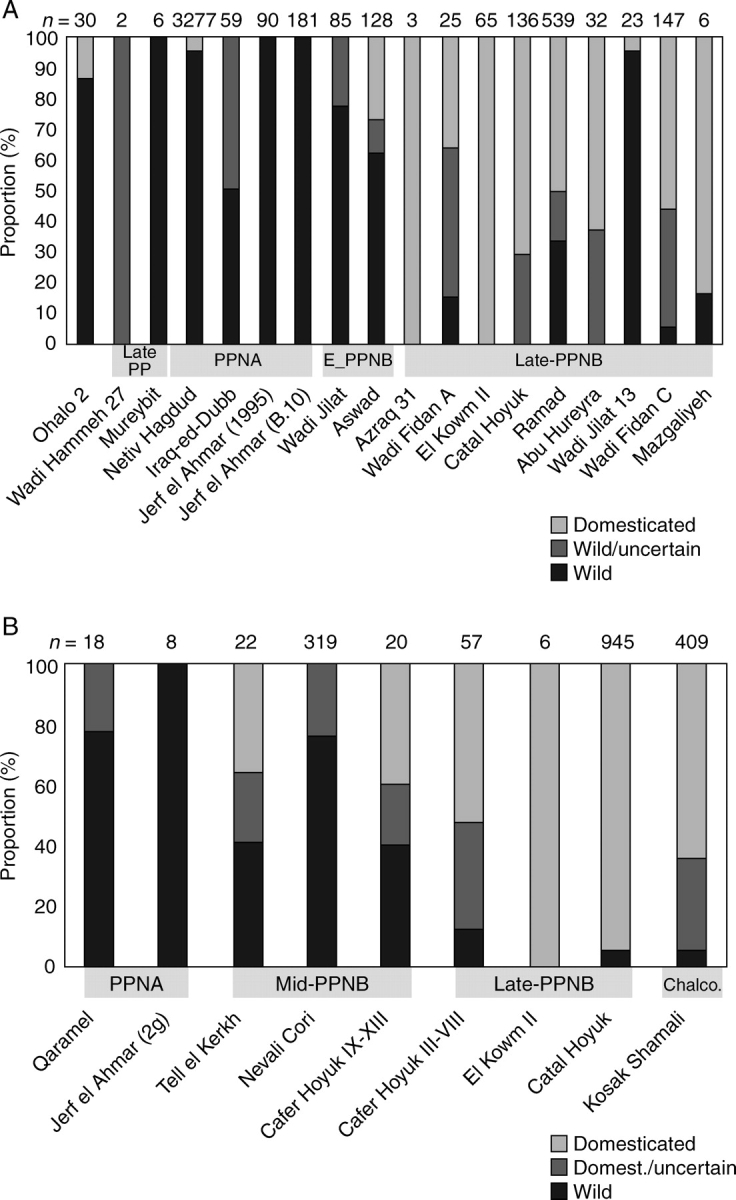Fig. 5.

Proportions of wild and domesticated barley and einkorn rachis/spikelet remains on early Near Eastern sites, arranged chronologically from left to right, and grouped into broader phases. (A) Barley rachis types, including domesticated (tough), wild (shattering) and uncertain (but more likely wild). (B) Proportions of einkorn spikelet forks/glume bases, including domesticated (tough), wild (shattering) and uncertain (but more likely domesticated). Sites, approximate ages and data sources: Ohalo 2, 21 000–18 500 BC (Kislev et al., 1992); Wadi Hammeh, approx. 12 000 BC (Colledge, 2001); Mureybit, 10 500–9500 BC (Van Zeist and Bakker Heeres, 1986); Iraq-ed-Dubb, approx. 9300 BC (Colledge, 2001); Jerf el Ahmar (early, with two-grained einkorn), 9700–9300 BC (Willcox, 1999, 2002); Wadi Jilat 7, 8800–8300 BC, Wadi Jilat 13, 7000–6500 BC (Colledge, 2001); Aswad, 8700–8000 BC (Van Zeist and Bakker Heeres, 1985; Tanno and Willcox, 2006a); Azraq 31, 7500–7000 BC (Colledge, 2001); Wadi Fidan A, 7500–7000 BC, Wadi Fidan C, 7000–6500 BC (Colledge, 2001); El Kowm, 7500–6800 BC (De Moulins, 1997); Catal Hoyuk, 7400–6800 BC (Fairbairn et al., 2002); Ramad, 7500–6500 BC (Van Zeist and Bakker Heeres, 1985; Tanno and Willcox, 2006a); Magzaliyeh, 7100–6400 BC (Willcox, 2006); Tell el Kherkh, 8600–8300 BC (Tanno and Willcox 2006a, b); Nevali Cori, 8500–8000 BC (Tanno and Willcox, 2006a); Qaramel, approx. 10000 BC (Tanno and Willcox, 2006a); Netiv Hagdud, 9500–9000 BC (Kislev, 1997); Cafer Hoyuk, (IX–XIII) 8300–7700 BC, (III–VIII) 7500–7000 BC (De Moulins, 1997); Kosak Shamali, approx. 5000 BC (Tanno and Willcox, 2006a).
